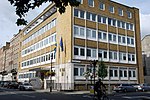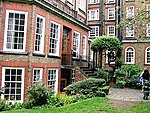Bryanston Square

Bryanston Square is an 800-by-200-foot (244 by 61 m) garden square in Marylebone, London. Terraced buildings surround it — often merged, converted or sub-divided, some of which remain residential. The southern end has the William Pitt Byrne memorial fountain. Next to both ends are cycle parking spaces. The most notable merger is the Swiss Embassy at the north-east end. The square's narrow ends are broken by broad approach streets of the same British Regency date. More recent style flanks the mid-west range of the square in the form of №s 31, 32 and 33 which are three times an ordinary range of its widths, meaning the numbering scheme today skips ten following numbers, destroyed to make room for these, to culminate with №s 44 to 50 and the highest-numbered buildings of Great Cumberland Place – its corner houses, №s 63 and 68. That street, this square and Wyndham Place run broad and straight for 750 metres without building projections between an 1821-built church and Marble Arch, moved to its permanent site in 1851. Traffic circulates clockwise around the square and numbering runs anti-clockwise.
Excerpt from the Wikipedia article Bryanston Square (License: CC BY-SA 3.0, Authors, Images).Bryanston Square
Bryanston Square, London Marylebone
Geographical coordinates (GPS) Address Nearby Places Show on map
Geographical coordinates (GPS)
| Latitude | Longitude |
|---|---|
| N 51.5175 ° | E -0.16083333333333 ° |
Address
Bryanston Square
Bryanston Square
W1H 7TX London, Marylebone
England, United Kingdom
Open on Google Maps









